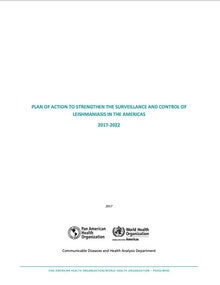The Leishmaniasis Plan of Action for the Americas is an instrument that consolidates the main lines of action to strengthen surveillance and control of the disease in the Region. Furthermore, it presents the process indicators to assess its progress, as well as the epidemiological and operational indicators to monitor the disease and progress in the quality of performed services and available information. It was elaborated from the guidelines and directives of the Global Leishmaniasis Program of the World Health Organization (WHO), adapted to the epidemiological characteristics and specific aspects of the Region, in order to reach the commitment assumed by the member countries, within the framework of the mandates approved by the World Health Assembly and the Directing Council of the Pan American Health Organization - PAHO/WHO, expressed by Resolutions WHA 60.13 of May 2007, WHA 66.12 of 2013, CD49. R19 of October 2009 and CD55.R09 of September 2016.
This plan of action is the result of an analysis of epidemiological data, technical discussions, agreements, and recommendations made by experts, researchers and professionals responsible for the actions to fight this disease in endemic countries, based on scientific evidence available in the Region. The actions proposed in this Plan were formulated from the diagnosis of the disease status in the Region, initially dividing them into two groups according to the type of disease: cutaneous and visceral leishmaniasis, which differ in clinical presentation, species of Leishmania, vectors, and reservoirs, as well as, characteristics of the transmission cycle, which makes the actions of surveillance and control different. The actions are focused on early diagnosis, adequate treatment and follow-up of affected people, surveillance, prevention and control of human cases, vectors and reservoirs when required.
|

